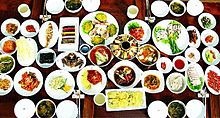| Korean table d'hôte | |
 | |
| Korean name | |
|---|---|
| Hangul | 한정식 |
| Hanja | 韓定食 |
| Revised Romanization | han-jeongsik |
| McCune–Reischauer | han-jŏngsik |
| IPA | [han.dʑʌŋ.ɕik̚] |
 |
| This article is part of a series on |
| Korean cuisine 한국 요리 조선 료리 |
|---|
Korean table d'hôte,[1] called han-jeongsik (한정식; 韓定食) in Korean,[1] is a Korean-style full-course meal characterized by the array of small banchan plates in varied colours.[2][3][4][5][6]
See also[edit]
- Bap (rice)
- Guk (soup)
- Banchan (side dishes)
- Table d'hôte
- Meze (Middle Eastern/Balkan meal)
- Smörgåsbord (Scandinavian meal)
- Thali (South and Southeast Asian meal)
References[edit]
- ^ a b National Institute of Korean Language (30 July 2014). "주요 한식명(200개) 로마자 표기 및 번역(영, 중, 일) 표준안" (PDF) (in Korean). Retrieved 14 February 2017.
- 주요 한식명 로마자 표기 및 표준 번역 확정안 공지. National Institute of Korean Language (Press release) (in Korean). 2014-05-02.
- ^ "han-jeongsik" 한정식 [Korean table d'hôte]. Korean–English Learners' Dictionary. National Institute of Korean Language. Retrieved 14 February 2017.
- ^ Chandler, Michael Alison (18 June 2011). "Discovering Korea's imperial past". The Washington Post. Retrieved 14 February 2017.
- ^ Slattery, Luke (21 April 2016). "How Korea's Seoul food puts other cuisines in the shade". Financial Review. Retrieved 14 February 2017.
- ^ Ali, Shereen (15 June 2016). "The beauty of Hansik". Trinidad and Tobago Guardian. Retrieved 14 February 2017.
- ^ "korean table d'hote".
Well, that’s interesting to know that Psilotum nudum are known as whisk ferns. Psilotum nudum is the commoner species of the two. While the P. flaccidum is a rare species and is found in the tropical islands. Both the species are usually epiphytic in habit and grow upon tree ferns. These species may also be terrestrial and grow in humus or in the crevices of the rocks.
View the detailed Guide of Psilotum nudum: Detailed Study Of Psilotum Nudum (Whisk Fern), Classification, Anatomy, Reproduction